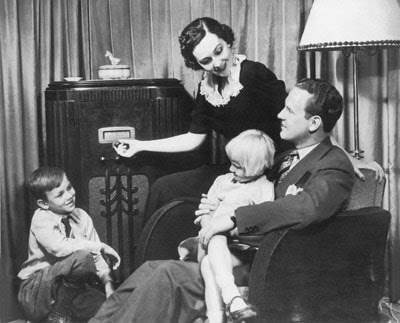
In August 1920, the stage was set for what would be the beginning of a profound transformation of the home entertainment revolution—the birth of commercial broadcasting . E.W. Scripps‘s WWJ in Detroit secured its commercial broadcasting license and embarked on a journey that would redefine home entertainment. From that moment, it has consistently delivered a regular schedule of programming, marking the inception of a home entertainment revolution.
Back then, stations owned by manufacturers and department stores emerged with a primary goal: to sell radios. Simultaneously, those owned by newspapers had a dual purpose—to vend papers and express the opinions of their owners. Little did they know that this pioneering era would set the foundation for a colossal shift in how families engage with entertainment within the comfort of their homes. The seeds of the Home Entertainment Revolution were sown, marking the beginning of an exciting and dynamic chapter in the way we experience content.
People loved to gather around their radios in their homes to listen to programs together as a family.
Programs became fixed in quarter-hour and half-hour blocks and featured a wide variety of formats. Soap operas such as Ma Perkins and The Guiding Light kept housewives company through the afternoon. Children listened to the adventure series Little Orphan Annie and the science-fiction show Flash Gordon. Amos ’n’ Andy, a situation comedy, was the most popular show ever broadcast, lasting more than 30 years. The Shadow, a crime drama, also had a loyal following. “Prestige” anthology shows brought together writers such as Archibald MacLeish and Norman Corwin with actors from the legitimate stage such as Helen Hayes and Orson Welles, and film-based anthology shows such as The Lux Radio Theatre and Academy Award Theater featured movie stars of the day reading live radio versions of their motion-picture roles. In 1938 Welles’s radio adaptation of H.G. Wells’ science-fiction tale The War of the Worlds created panic when listeners failed to hear the disclaimer and believed Martians actually were invading Earth.
Over time the technology improved, and people watched more and more television and less radio programs. What we lost was the ability to use our imagination to create in our minds what the radio programs offered, a deeper experience than simply watching images on tv.
However, listening to music over a radio broadcast has always been a staple of American culture. Technology has changed how we listen to music, mono vs stereo, large amplified systems to small hand-held portable radios, CD players, and now MP3 players.
In our homes the best experience for most seems to be an open broadcast through quality speakers. Like going to a concert, we love hearing all the rich tones of each instrument, the thumping of the bass guitar, the drums and cymbals, all mixed together with vocals of many different genres and we like it loud!
There are systems in very wealthy homes that might cost $100,000 that would feature “theater/concert” quality speakers, room to room options, sub-woofers at 10,000 watts with amazing clarity. But most music lovers would not be on-board with a cost like that when you can get great sound through something much less expensive.
In the 70’s you could get a rack stereo system with a phono, graphic equalizer, AM/FM Stereo with tower speakers that would give you a great music experience. Some of that “old technology” is still used today with better results than minimizing down to headphones.
For instance, most music snobs would suggest that listening to music on a phono recording is much better than CD. It seems to give it a more “live” affect, a broader listening experience, less perfect so it’s better. Others will say that when you listen to music through quality headphones you can achieve that same experience. It just depends on the listener’s own taste in music quality, affordability, space availability and if they prefer a more mobile option.
Our cars have changed over the years also! You can not get surround sound in quality luxury vehicles that will give you a concert-type sound all built in with MP3, Bluetooth, Sirius XM and DVD Players.
If you are looking for a “built-in” option for your home, Intrasonic Technology has options that will meet your budget requirements and give you quality sound in several rooms.









